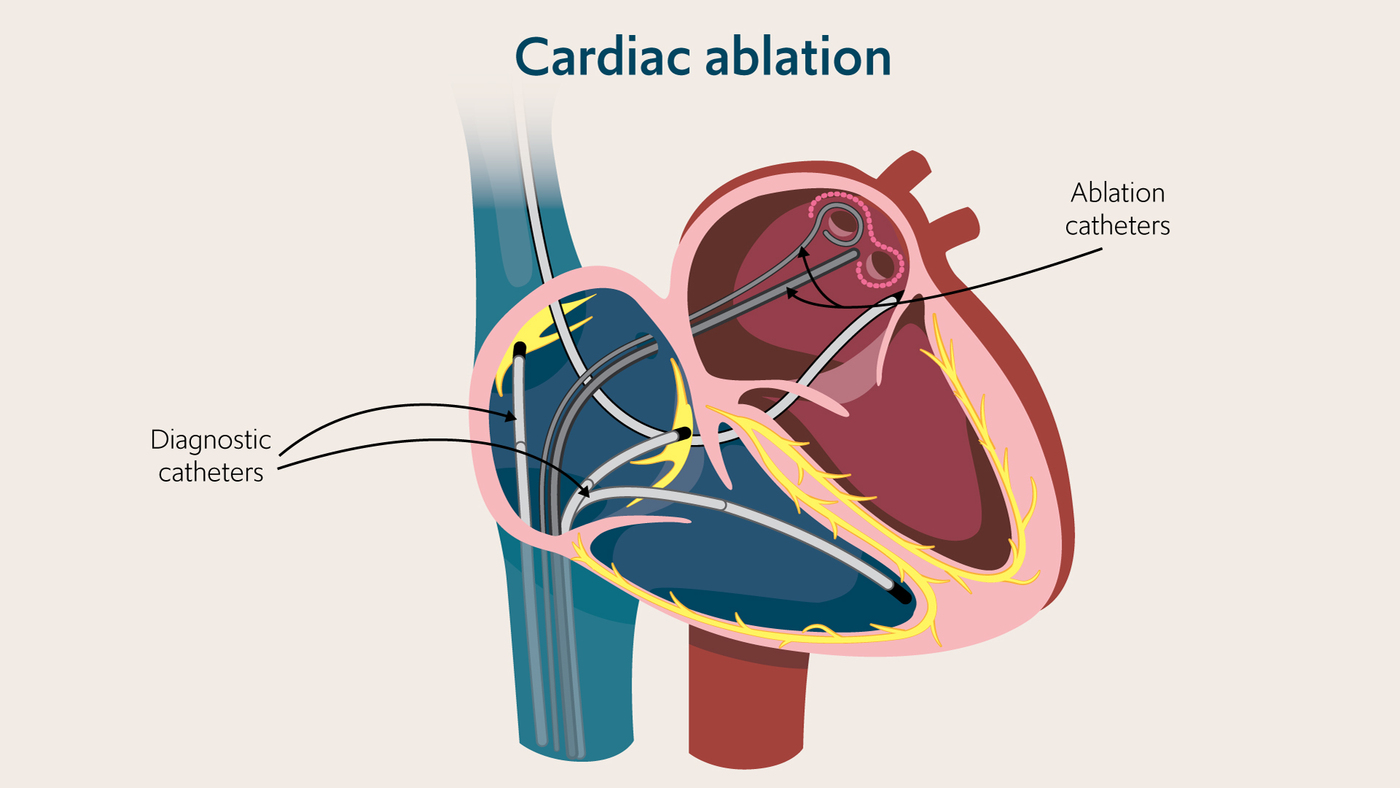What is cardiac ablation?
Cardiac ablation, also known as ‘catheter ablation,’ is an advanced procedure used to treat irregular and fast heart rhythms, known as ‘cardiac arrhythmias’.
This minimally invasive treatment aims to restore your heart’s regular rhythm by blocking abnormal electrical pathways. It uses either heat (radiofrequency energy), freezing (cryoablation) or electric current (electroporation) to target and eliminate the specific heart muscle region responsible for the irregular rhythms.
Cardiac ablation is a drug-free treatment for abnormal heart rhythms, designed to create controlled damage in the problematic heart area.
This process forms scar tissue that disrupts abnormal electrical circuits and eliminates the sources of the rhythm disturbances.
Who can benefit from cardiac ablation?
Cardiac ablation is suitable for people with symptoms caused by heart arrhythmias that interfere with daily life and overall well-being. It’s also considered when medical treatments have not effectively managed the arrhythmia.
Success rates for cardiac ablation are impressive, with approximately nine out of ten people benefiting from the procedure.
Cardiac ablation can treat several conditions, including:
- supraventricular tachycardia (SVT): an abnormal heart rhythm from the top of the heart. Characterised by rapid heartbeats, often occurring during physical activity or at rest
- atrial flutter: a rhythm disorder of the heart’s upper chambers, often associated with underlying heart issues
- atrial fibrillation (AF): a condition where the upper chambers of the heart beat irregularly, increasing the risk of stroke and heart failure
- ventricular tachycardia (VT): an abnormal heart rhythm from the bottom of the heart which can lead to palpitations and may be life threatening

How does cardiac ablation work?
Cardiac ablation is typically performed in a specialised cardiac catheter laboratory (cath lab). The procedure can last from 1 to 4 hours, depending on complexity.
How to prepare for cardiac ablation
Diagnostic tests such as blood tests, electrocardiogram (ECG), heart rhythm monitoring, chest X-ray, echocardiogram, computed tomography (CT) angiogram, and magnetic resonance imaging (MRI) are conducted to assess your heart’s condition and overall health. Lifestyle adjustments, medication, and anticoagulation therapy may be recommended.
The procedure
The specialist inserts flexible catheters into blood vessels at the top of your leg on one or both sides and guides them into the heart using X-ray imaging.
Advanced technologies are used to record electrical activity, pinpoint the rhythm issue using detailed maps of the inside of the heart, and then deliver ablation energy to create scar tissue. The damaged tissue disrupts the abnormal signals often restoring normal rhythm.
Validation
The specialist ensures that targeted areas have been treated and that the normal rhythm has returned using an electric shock if necessary, and then removes the catheters and presses on the leg to stop the bleeding.
Before your procedure
Before your procedure, there are many steps you can take to improve your health and prevent complications. These include:
- stop smoking at least two weeks before your ablation to reduce complications and improve healing
- see your GP to ensure any chronic medical problems like hypertension, bronchitis, and diabetes are well-controlled
- your team will provide individual advice on taking your regular medications before the procedure
- if you do not take blood thinners, your doctor may start anticoagulant treatment at least six weeks before your ablation. You should continue treatment following your ablation; then, your team will review your anticoagulant therapy at your three-month check-up
- your doctor may prescribe an acid-blocking drug called lansoprazole. It reduces gastric acid production in the stomach and reduces the risk of irritation in your gullet (oesophagus) which is close to the left atrium
Cardiac ablation recovery
After the procedure, you are monitored and supported in the recovery unit.
Dressings cover the incision sites, and pain and bruising are managed with painkillers. Bed rest helps minimize the risk of bleeding.
Most patients can return home on the day of the procedure, sometimes with an echocardiogram performed before discharge if the doctor believes it necessary. A follow-up appointment will be scheduled, and you should contact the team if any concerns arise.
Benefits of cardiac ablation
Cardiac ablation can treat heart rhythm problems and reduce the need for medication. Success rates depend upon the condition but can range from 50-90% of patients benefitting from the procedure.
Risks of cardiac ablation
While complications are infrequent, potential risks include bleeding from the blood vessels in the leg, stroke, bleeding around the heart, blood clots, the need for a pacemaker, infection, skin damage and rarely emergency cardiac surgery.
In extremely rare cases, complications can lead to death, but this risk should be carefully weighed against the potential dangers of untreated arrhythmias. Around one in 1,000 people die following the procedure.
Consult with your doctor to discuss the specific benefits and risks related to your condition.
Locations
Our experts can offer treatment for cardiac ablation in the following locations:
Discovery our cardiology specialists
Meet our team of renowned cardiology experts. From cardiovascular health assessments to innovative interventions, our specialists are committed to delivering personalised care designed just for you
